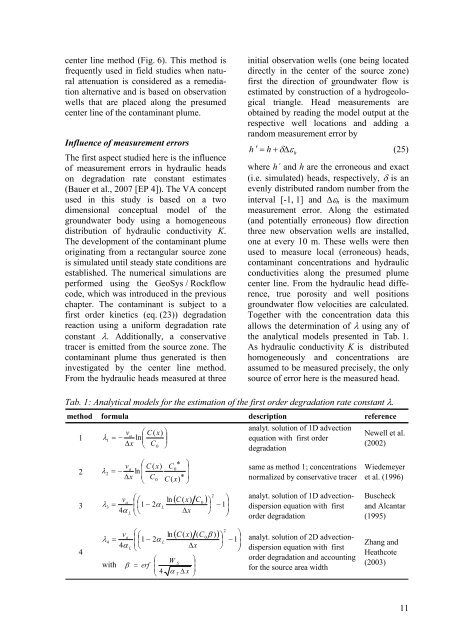Applied numerical modeling of saturated / unsaturated flow and ...
Applied numerical modeling of saturated / unsaturated flow and ...
Applied numerical modeling of saturated / unsaturated flow and ...
You also want an ePaper? Increase the reach of your titles
YUMPU automatically turns print PDFs into web optimized ePapers that Google loves.
center line method (Fig. 6). This method is<br />
frequently used in field studies when natural<br />
attenuation is considered as a remediation<br />
alternative <strong>and</strong> is based on observation<br />
wells that are placed along the presumed<br />
center line <strong>of</strong> the contaminant plume.<br />
Influence <strong>of</strong> measurement errors<br />
The first aspect studied here is the influence<br />
<strong>of</strong> measurement errors in hydraulic heads<br />
on degradation rate constant estimates<br />
(Bauer et al., 2007 [EP 4]). The VA concept<br />
used in this study is based on a two<br />
dimensional conceptual model <strong>of</strong> the<br />
groundwater body using a homogeneous<br />
distribution <strong>of</strong> hydraulic conductivity K.<br />
The development <strong>of</strong> the contaminant plume<br />
originating from a rectangular source zone<br />
is simulated until steady state conditions are<br />
established. The <strong>numerical</strong> simulations are<br />
performed using the GeoSys / Rock<strong>flow</strong><br />
code, which was introduced in the previous<br />
chapter. The contaminant is subject to a<br />
first order kinetics (eq. (23)) degradation<br />
reaction using a uniform degradation rate<br />
constant �. Additionally, a conservative<br />
tracer is emitted from the source zone. The<br />
contaminant plume thus generated is then<br />
investigated by the center line method.<br />
From the hydraulic heads measured at three<br />
initial observation wells (one being located<br />
directly in the center <strong>of</strong> the source zone)<br />
first the direction <strong>of</strong> groundwater <strong>flow</strong> is<br />
estimated by construction <strong>of</strong> a hydrogeological<br />
triangle. Head measurements are<br />
obtained by reading the model output at the<br />
respective well locations <strong>and</strong> adding a<br />
r<strong>and</strong>om measurement error by<br />
h � � h � ���<br />
(25)<br />
h<br />
where h´ <strong>and</strong> h are the erroneous <strong>and</strong> exact<br />
(i.e. simulated) heads, respectively, � is an<br />
evenly distributed r<strong>and</strong>om number from the<br />
interval [-1, 1] <strong>and</strong> ��h is the maximum<br />
measurement error. Along the estimated<br />
(<strong>and</strong> potentially erroneous) <strong>flow</strong> direction<br />
three new observation wells are installed,<br />
one at every 10 m. These wells were then<br />
used to measure local (erroneous) heads,<br />
contaminant concentrations <strong>and</strong> hydraulic<br />
conductivities along the presumed plume<br />
center line. From the hydraulic head difference,<br />
true porosity <strong>and</strong> well positions<br />
groundwater <strong>flow</strong> velocities are calculated.<br />
Together with the concentration data this<br />
allows the determination <strong>of</strong> � using any <strong>of</strong><br />
the analytical models presented in Tab. 1.<br />
As hydraulic conductivity K is distributed<br />
homogeneously <strong>and</strong> concentrations are<br />
assumed to be measured precisely, the only<br />
source <strong>of</strong> error here is the measured head.<br />
Tab. 1: Analytical models for the estimation <strong>of</strong> the first order degradation rate constant �.<br />
method formula description reference<br />
1<br />
2<br />
3<br />
4<br />
v � �<br />
a C ( x)<br />
� � � �<br />
�<br />
�<br />
�<br />
1 ln<br />
�x<br />
� C0<br />
�<br />
v � � �<br />
a � C ( x)<br />
C0<br />
� � �<br />
�<br />
2 ln<br />
�x<br />
� C � �<br />
� 0 C ( x)<br />
�<br />
with<br />
�C( x)<br />
C �<br />
2<br />
v �<br />
�<br />
a ��<br />
ln<br />
0 �<br />
�<br />
� �<br />
3 �<br />
�<br />
�1<br />
� 2�<br />
L<br />
� 1<br />
4�<br />
�<br />
L ��<br />
�x<br />
� �<br />
�C( x)<br />
( C � ) �<br />
2<br />
v �<br />
�<br />
a ��<br />
ln<br />
0 �<br />
�<br />
� �<br />
4 �<br />
�<br />
�1<br />
� 2�<br />
L<br />
� 1<br />
4�<br />
�<br />
L ��<br />
�x<br />
� �<br />
� �<br />
�<br />
W S<br />
� � erf<br />
�<br />
� �<br />
� 4 � T � x �<br />
analyt. solution <strong>of</strong> 1D advection<br />
equation with first order<br />
degradation<br />
same as method 1; concentrations<br />
normalized by conservative tracer<br />
analyt. solution <strong>of</strong> 1D advectiondispersion<br />
equation with first<br />
order degradation<br />
analyt. solution <strong>of</strong> 2D advectiondispersion<br />
equation with first<br />
order degradation <strong>and</strong> accounting<br />
for the source area width .<br />
Newell et al.<br />
(2002)<br />
Wiedemeyer<br />
et al. (1996)<br />
Buscheck<br />
<strong>and</strong> Alcantar<br />
(1995)<br />
Zhang <strong>and</strong><br />
Heathcote<br />
(2003)<br />
11

















